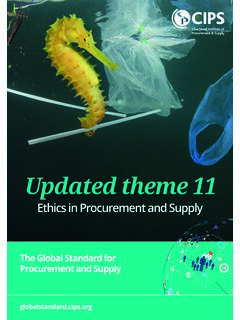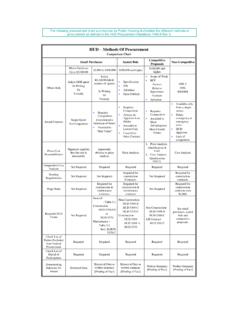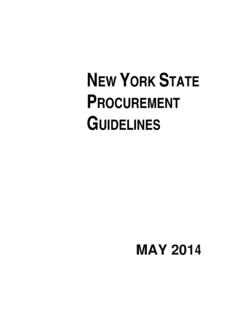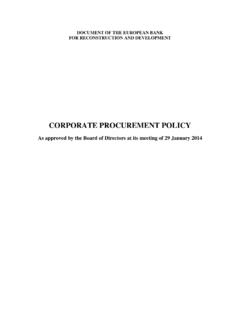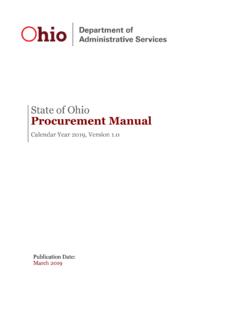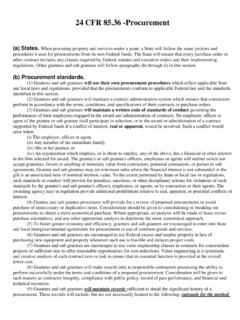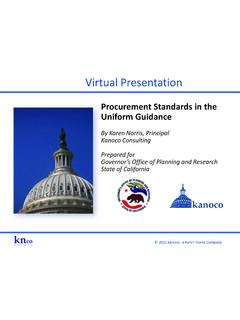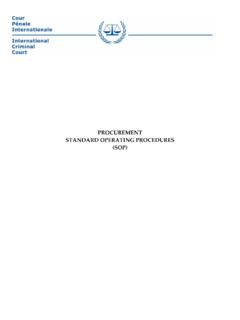Transcription of Guidance Note on Procurement: Contract Management
1 ASIAN DEVELOPMENT BANKCONTRACT MANAGEMENTGUIDANCE NOTE ON PROCUREMENTDECEMBER 2021 ASIAN DEVELOPMENT BANKCONTRACT MANAGEMENTGUIDANCE NOTE ON PROCUREMENTDECEMBER 2021 Creative Commons Attribution-NonCommercial-NoDerivs IGO license (CC BY-NC-ND IGO) 2021 Asian Development Bank6 ADB Avenue, Mandaluyong City, 1550 Metro Manila, PhilippinesTel +63 2 8632 4444; Fax +63 2 8636 rights reserved. Published in 2021. ISBN 978-92-9269-269-8 (print); 978-92-9269-270-4 (electronic)Publication Stock No. TIM210515-2 DOI: The views expressed in this publication are those of the authors and do not necessarily reflect the views and policies of the Asian Development Bank (ADB) or its Board of Governors or the governments they represent. ADB does not guarantee the accuracy of the data included in this publication and accepts no responsibility for any consequence of their use.
2 The mention of specific companies or products of manufacturers does not imply that they are endorsed or recommended by ADB in preference to others of a similar nature that are not making any designation of or reference to a particular territory or geographic area, or by using the term country in this document, ADB does not intend to make any judgments as to the legal or other status of any territory or work is available under the Creative Commons Attribution-NonCommercial-NoDerivs IGO license (CC BY-NC-ND IGO) By using the content of this publication, you agree to be bound by the terms of this license. For attribution and permissions, please read the provisions and terms of use at # CC license does not apply to non-ADB copyright materials in this publication. If the material is attributed to another source, please contact the copyright owner or publisher of that source for permission to reproduce it.
3 ADB cannot be held liable for any claims that arise as a result of your use of the contact if you have questions or comments with respect to content, or if you wish to obtain copyright permission for your intended use that does not fall within these terms, or for permission to use the ADB to ADB publications may be found at : In this publication, $ refers to United States dollars. Printed on recycled paperCONTENTSA bout this Publication ivAbbreviations viiExecutive Summary viiiI. Introduction 1II. Objective and Benefits of Contract Management 4 III. The Contract Management Process 6IV. Reporting to and Requesting No-Objection from ADB 18V. Resources for Further Review 19 Appendixes 1: Typical Contract Management Issues 20 2: Example of A Risk Management Plan 22 3: Manual on Contract Management 25 4: Example of Application of the Contract Management Plan 74ivList of Guidance Notes for the 2017 ADB procurement Policy and the procurement Regulations1.
4 Value for Money2. procurement Risk Framework3. Strategic procurement Planning4. procurement Review5. Alternative procurement Arrangements6. Open Competitive Bidding7. Price Adjustment8. Abnormally Low Bids9. Domestic Preference10. Prequalification11. Subcontracting12. Consulting Services Administered by ADB Borrowers13. Nonconsulting Services Administered by ADB Borrowers14. High-Level Technology15. Quality16. Bidding-Related Complaints17. Noncompliance in Procurement18. Standstill Period19. State-Owned Enterprises20. E-Procurement21. Framework Agreements for Consulting Services22. Public Private Partnerships23. Contract Management24. Fragile, Conflict-Affected, and Emergency Situations25. Sustainable Public Procurement26. Use of Merit Point Criteria for Bid EvaluationABOUT THIS PUBLICATIONIn April 2017, the Asian Development Bank (ADB) approved its new procurement framework, the ADB procurement Policy: Goods, Works, Nonconsulting and Consulting Services (2017, as amended from time to time); and the procurement Regulations for ADB Borrowers: Goods, Works, Nonconsulting and Consulting Services (2017, as amended from time to time).
5 These replace the former Guidelines on the Use of Consultants (2013, as amended from time to time) and procurement Guidelines (2015, as amended from time to time). The procurement policy and the procurement regulations address the procurement activities of project executing agencies and implementing agencies on projects financed in whole or in part by a loan or grant from ADB, or by ADB-administered funds. ADB designed the 2017 procurement policy to deliver significant benefits and flexibility throughout the project procurement cycle, as well as to improve project delivery through a renewed focus on the concepts of quality, value for money (VFM), and fitness for note is part of a series of Guidance notes published by ADB in 2018 to accompany the 2017 procurement policy and the procurement regulations. Each note discusses a topical issue for borrowers (including grant recipients), bidders, and civil society under the new framework (see list below).
6 The Guidance notes cross reference each other frequently and should be read in conjunction. All references to Guidance notes pertain to these notes. The notes may be updated, replaced, or withdrawn from time to this PublicationvADB procurement reforms intend to ensure VFM by improving flexibility, quality, and efficiency throughout the procurement cycle (see illustration below and the Guidance Note on Value for Money). VFM is part of a holistic procurement structure with three support pillars: efficiency, quality, and flexibility. The two key principles of transparency and fairness weave across all elements of the is an important element of VFM. When a project is delivered promptly or when a process is completed rapidly, greater value is created for all stakeholders. For example, a road project completed early provides economic benefit, security, or other value to the community it serves.
7 It increases the return on investment to the executing agency and accelerates the project and payment cycle to the successful bidder. Likewise, a project delivered late loses significant value. When considering VFM in the context of procurement , pay attention to anything that (i) shortens the procurement cycle timeframe, or (ii) accelerates delivery of the development for MoneyThe effective, efficient, and economic use of resources, which requires an evaluation of relevant costs and benefits along with an assessment of risks, nonprice attributes, and/or total cost of ownership as appropriateEfficiencyQualityFlexibility Decreased transaction costs Increased skills Increased high-level technology usage Improved procurement planning Support and encouragement of e- procurement systems Contract Management support Prompt resolution of complaints Improved developing member country procurement process Improved procurement planning Governance Contracts with clear performance criteria Minimal number of complaints Improved ADB processes Open competitive bidding Decentralization Accreditation for alternative procurement arrangements Principles-based decisions Improved procurement planning Delegation Bids with weighted proposal criteria FairnessAbout this PublicationviObjectiveThis Guidance note is intended to assist readers by
8 Elaborating on and explaining ADB s 2017 procurement policy and procurement regulations for borrowers (including grant recipients). This note identifies additional information for the reader to consider when applying ADB s procurement policy and procurement regulations to their circumstances. Living DocumentThis Guidance note is intended to be a living document and will be revised as sure to check the ADB Business Center website for the latest version and updates, Reader In many circumstances, readers are expected to use this Guidance note in a manner unique to their needs. For consistency throughout the suite of Guidance notes, the following assumption is made about the reader:The reader is a professional involved in activities financed in whole or in part by an ADB loan or grant, or by ADB-administered funds. FAQsFrequently asked questions, clarifications, examples, additional information, links to training, and other useful resources will be made available on the ADB website.
9 Be sure to check the ADB Business Center website for more information, and Order of PriorityThis Guidance note explains and elaborates on the provisions of the procurement Regulations for ADB Borrowers: Goods, Works, Nonconsulting and Consulting Services (2017, as amended from time to time) applicable to executing (and implementing) agencies under sovereign (including subsovereign) projects financed in whole or in part by an investment loan from ADB ( , excluding ADB results- or policy-based loans), ADB-financed grant (excluding ADB-administered technical assistance and staff consultancies), or by ADB-administered funds. In the event of any discrepancy between this Guidance note and the procurement regulations, the latter will prevail. The financing agreement governs the legal relationships between the borrower and ADB. The rights and obligations between the borrower and the provider of goods, works, or services are governed by the specific procurement document issued by the borrower and by the Contract signed between the borrower and the provider, and not by this Guidance Asian Development BankAPG advance payment guaranteeCCP community communication planCEMP contractor s environment Management plan CMP Contract Management planCSPRA country sector (agency) procurement risk assessmentDNP defect notification periodEOT extension of timeEMP environment Management planENAA Engineering Advancement Association of JapanFIDIC F d ration Internationale des Ing nieurs-Conseils (International Federation of Consulting Engineers)
10 GCC General Conditions of Contract ESHS environment, social, and health and safety LARP Land Acquisition and Resettlement PlanLOA Letter of AcceptanceMDB multilateral development bankPCC Particular Conditions of ContractPIU project implementation unit PMC project Management consultantPMU project Management unitPMO project Management officePPFD procurement , Portfolio and Financial Management DepartmentPPRA project procurement risk assessmentRMG Retention Money GuaranteeSPP Strategic procurement PlanningVFM value for moneyviiiEXECUTIVE SUMMARYThis Guidance Note on Contract Management explains the basic principles of Contract Management and proposes a structured and step-by-step approach to implement it. Recognizing the need to deliver value for money, the Guidance note emphasizes demonstrating the benefits of good Contract Management and how it may be applied in operations financed by the Asian Development Bank (ADB).










